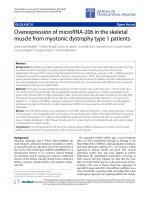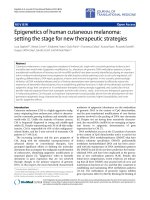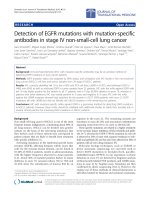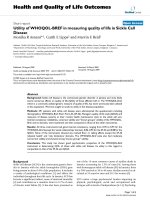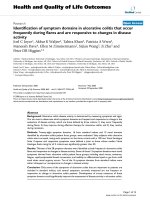Báo cáo hóa học: " Detection of epithelial apoptosis in pelvic ileal pouches for ulcerative colitis and familial adenomatous polyposis" pot
Bạn đang xem bản rút gọn của tài liệu. Xem và tải ngay bản đầy đủ của tài liệu tại đây (7.03 MB, 6 trang )
RESEA R C H Open Access
Detection of epithelial apoptosis in pelvic ileal
pouches for ulcerative colitis and familial
adenomatous polyposis
Raquel F Leal
1*
, Maria de Lourdes S Ayrizono
1
, Marciane Milanski
2
, João J Fagundes
1
, Juliana C Moraes
2
,
Luciana R Meirelles
3
, Lício A Velloso
2
, Cláudio SR Coy
1
Abstract
Background: Ileal pouch-anal anastomosis (IPAA) is the surgical procedure of choice for pa tients with refractory
ulcerative colitis (UC) and for familial adenomatous polyposis (FAP) with many rectal polyps. Pouchitis is one of the
more frequent complications afte r IPAA in UC patients; however, it is rare in FAP.
Objective: Evaluate pro-apoptotic activity in endoscopically and histological normal mucosa of the ileal pouch in
patients with UC and FAP.
Methods: Eighteen patients (nine with UC and nine with FAP) with J pouch after total rectocolectomy were
studied. Biopsies were obtained from the mucosa of the pouch and from normal ileum. The specimens were snap-
frozen and the expressions of Bax and Bcl-2 were determined by immunoblot of protein extracts and by
immunohistochemistry analysis. FADD, Caspase-8, APAF-1 and Caspase-9 were evaluated by immunoprecipitation
and immunoblot.
Results: Patients with UC had significantly higher protein levels of Bax and APAF-1, Caspase-9 than patients with
FAP, but were similar to controls. The expressions of Bcl-2 and FADD, Caspase-8 were similar in the groups.
Immunohistochemistry for Bax showed less intensity of immunoreactions in FAP than in UC and Controls. Bcl-2
immunostaining was similar among the groups.
Conclusion: Patients with FAP present lower levels of pro-apoptotic proteins in all methods applied, even in the
absence of clinical and endoscopic pouchitis and dysplasia in the histological analysis. These findings may explain
a tendency of up-regulation of apoptosis in UC patients, resulting in higher rates of progression to pouchitis in
these patients, which could correlate with mucosal atrophy that occurs in inflamed tissue. However, FAP patients
had low pro-apoptotic activity in the mucosa, and it could explain the tendency to low cell turn over and
presence of adenomas in this syndrome.
Backgroud
Restorative rectocolectomy with ileal pouch and anal
anastomosis (IPAA) has become th e surgical procedure
of choice for ulcerative colitis (UC) and for familial ade-
nomatous polyposis (FAP), for three decades [1-3].
Despite of its innumerous advantages over other thera-
peutic procedures, restorative retocolectomy with ileal
pouch may evolve with pouchitis, a complication that
affects up to 50% of patients with UC, and only 5% of
patients with FAP [4-6].
Although pouchitis is a commonly reported complica-
tion, its etiology remains unknown [7-11]. Due to this
difference in the incidence of pouchitis, some authors
have proposed that the reactivation of UC may have a role
in the induction of the local inflammation and in the
increased epithelial apoptosis that will, ultimately, lead to
the installation of this complication [12,13]. This hypoth-
esis is further boosted by the fact that some patients with
pouchitis have resurgence of extra-intestinal manifesta-
tions of UC in the same way as patients who have active
* Correspondence: r
1
Coloproctology Unit of the Surgery Department, University of Campinas
(UNICAMP), Medical School, São Paulo, Brazil
Leal et al. Journal of Translational Medicine 2010, 8:11
/>© 2010 Leal et al; licensee BioMed Central Ltd. This is a n Open Access article distributed under the terms of the Creative Commons
Attribution License ( which permits unrestricted use, distribution, and reproduction in
any medium, provided the original wor k is properly cited.
UC [14,15], and by data supporting a goal for increased
apoptosis that occurs in active UC mucosa [16,17]. The
study of intrinsic and extrinsic apoptosis pathways in ileal
pouch remains not completely available and there are few
studies in the literature that have evaluated this putative
role of pouchitis etiology.
Therefore, in order to compare the apoptotic activity
in asymptomatic pouches between the highly pouchitis-
prone UC patients and the pouchitis-protected patients
with F AP we employed immunoblotting, immunopreci-
pitation assays and histological analysis to determine the
expression of pro-apoptotic and anti-apoptotic protein s,
and detection of apoptosis by Annexin V fluorescence
microscopy in ileal pouch biopsies.
Methods
Mucosal biopsies were taken from nine patients with
non-inflamed IPAA after rectocolectomy for UC [med-
ian age 48.7 (range, 31-63) years; male 44.4%; female
55.6%], and nine patients with non-inflamed IPAA after
rectocolectomy for FAP [median age 33.8 (ra nge, 21-59)
years; male 44.4%; female 55.6%]. The follow-up after
the operation was 73.1 (24-168) months. The reservoir
design was of the “J” type in all patients, and the right
colon vascular arcade was preserved as a supplementary
blood supply to the terminal ileum [18]. Mucosectomy
was performed, with hand-sewn ileo-anal anastomosis.
The patients had had their ileostomy closed for more
than one year, at the time of the study. The absence of
pouchitis was defined clinically, histology and endosco-
pically, according to the PDAI [19]. The control group
was composed of nine individuals with normal colono-
scopy examination, with a median age of 40.9 (range, 26
- 58) years and 55.6% were female. Six biopsies of each
patient were obtained from terminal ileum (control) and
from ileal pouch (UC and FAP).
The study was performed in accordance with the
Declaration of Helsinki and was approved by the local
ethical committee. All biopsies were taken after
informed consent from the patients. The study was car-
ried out at the State University of Campinas, Coloproc-
tology Unit, and at the Cell Signaling Laboratory of the
Department of Internal Medicine.
• Immunoblotting - Gel electrophoresis
Mucosal biopsies from the pouches and from normal
ileum were snap-froz en in liqu id nitrogen and stored at
-80°C until use. For total protein extract preparation,
the fragments were homogenized in solubilization buffer
at 4°C [1% Triton X-100, 100 mM Tris-HCl (pH 7.4),
100 mM sodium pyrophosphate, 100 mM sodium fluor-
ide, 10 mM EDTA, 10 mM sodium orthovanadate, 2.0
mM phenylmethylsulfonyl fluoride (PMSF), and 0.1 mg
aprotinin/ml] with a Polytron PTA 20S generator
(model PT 10/35; Brinkmann I nstruments, Westbury,
NY)operatedatmaximumspeedfor30sec.Insoluble
material was removed by centrifugation (20 min at 9000
× g at 4°C). The protein concentrations of the superna-
tants were determined by the Bradford dye binding
method [20]. Aliquots of the resulting supernatants con-
taining 100 μg total proteins were separated by SDS-
PAGE, transferred to nitrocellulose membranes and
blotted with anti-Bax, anti-Bcl-2 antibodies [ 21,22]. In
immunoprecipitation experiments, samples containing
1.0 mg protein were incubated overnight with antibodies
against FADD and APAF-1. The immunocomplexe s
were recovered with Protein A Sepharose, separated by
SDS-PAGE, transferred to nitrocellulose membranes,
and blotted with anti-Caspase-8 to FADD (extrinsic
pathway apoptosis), and anti-Caspase-9 to APAF-1 anti-
bodies (intrinsic pathway apoptosis) [21].
Reagents for SDS-PAGE, immunoblotting and immu-
noprecipitation were from Bio-Rad Laboratories (Rich-
mond, CA). Phenylmethylsulfonyl fluoride, aprotinin,
Triton X-1 00, Tween 20, glycerol were from Sigma (St.
Louis, MO). Protein A-Sepha rose 6 MB was from Phar-
macia (Uppsala, Sweden), and nitrocellulose paper
(BA85, 0.2 μm) was fr om Amersham (Aylesbury, UK).
The anti-Bax (sc-493, rabbit polyclonal), anti-Bcl-2 (sc-
492, rabbit polyclonal), anti-FADD (sc-5559, rabbit poly-
clonal), anti-Caspase-8 (sc-7890, rabbit polyclonal), an ti-
APAF-1 (sc 26685, goat polyclonal) and anti-Caspase -9
(sc-7885, rabbit poly clonal) antibodies were purchased
from Santa Cruz Biotechnology, Inc. (Santa Cruz, CA).
The signal was detected by chemiluminescent reaction
(SuperSignal® West Pico Chemiluminescent Substrate
from Pierce Biothecnology, Inc. Rockford).
All numerical results are expressed as the mean
± SEM of the indicated number of experiments. The
results of blots are presented as direct comparisons
of bands in autoradiographs and quantified by densito-
metry using the Gel-Pro Analyzer 3.1 software (Exon-
Intron Inc., Farrell, MD). Data were analyzed by
repeat-measure ANOVA (one-way or two-way
ANOVA) followed by analysis of significance (Tuk ey-
Kramer Multiple Comparisons test), comparing UC,
FAP, and control groups. The level of significance was
set at p < 0 .05.
• Bax and Bcl-2 Immunohistochemistry
For immunostaining procedures, endogenous peroxidase
was blocked with 3% hydrogen peroxide/10 mM PBS
pH 6.0 for 15 min. Afterwards, the sections were micro-
waved in 3% milk buffer for 30 min and incubated over-
night with primary antibo dy either to Bax or Bcl-2
(DAKO A/S Denmark; A3533, rabbit polyclonal and
M0887, mouse polyclonal) applied in 1:500 and 1:150
dilution respectively at 20°C. The sections were
Leal et al. Journal of Translational Medicine 2010, 8:11
/>Page 2 of 6
incub ated with post primary block and polymer second-
ary antibodies (Novocastra™ Laboratories Ltd; Novolink
RE 7260-K) for 1 h, and processed for DAB reaction,
0.5 mg/ml (Sigma, USA, St Louis). Any cell type show-
ing cytoplasmic staining was considered positive for
qualitative analysis [23,24].
Results
Patients with UC had significantly higher levels of Bax,
APAF-1 and Caspase -9 than FAP (p < 0.05), but were
similar to controls (p > 0.05). The comparison of local
levels of Bcl-2 in pouches from UC, FAP patients and
controls revealed that they were similar among the
groups (p > 0.05).
The expression of FADD and Caspase-8 was similar
among the groups (p < 0.05), however there was a ten-
dency of high levels in UC patients when compared to
other groups (p = 0.08).
The d etermination of proteins expressions are shown
in Figure 1.
Figure 1 Representative Western blot analyses and determination of Bax, Bcl-2, FADD - Caspase-8, APAF-1 - Caspase-9 protein
expressions in non-inflamed pouches in the Control, FAP and UC groups. For illustration purpose each line band represents one patient.
For all conditions, n = 09, *p < 0.05 vs Control; §p < 0.05 vs FAP.
Leal et al. Journal of Translational Medicine 2010, 8:11
/>Page 3 of 6
With regard to immunohistochemistry, it showed that
immunoreactivity for Bax and Bcl-2 were detecte d in all
groups. Bcl-2 immunostaining pattern was similar
among the groups (Figure 2).
Discussion
Pouchitis is a common complication of total rectocolect-
omy with ileal pouch-anal anastomosis [25]. The etiol-
ogy of primary pouchitis remains uncertain and several
theories have been suggested like recurrence of UC in
ileal pouch. This fact precluded the development of
appropriate prophylaxis and treatment.
The fecal stream and stasis play an important part in
the patho genesis of immunologica l reactions in the ileal
pouch, but don’t explain the difference in incidence of
pouchitis in UC and FAP patients. There were immuno-
logical changes in the pouch for at least one year after
ileostomy closure in adaptation way after this surgery
[26]. Our patient s in this study had mor e than 1 yr of
follow-up after ileostomy closure, in order to evaluate
Figure 2 Immunohistochemistry of ileal pouch sections from UC, FAP and control group immunoreacted for Bax and Bcl-2.
Immunostainig for Bax was intense in UC group. Bcl-2 positive cell among the groups was similar. (200×)
Leal et al. Journal of Translational Medicine 2010, 8:11
/>Page 4 of 6
apoptosis activity that could lead to pouchitis after this
transitional period.
Several cytokines have been reported in ileal pouches,
showing that pro-inflammatory cytokines like TNF-a,
IL-1b, IL-6, IL-8, IFN-g are elevat ed in UC patients , but
poorly studied in FAP [4,27-30].
The inflammatory and apoptosis pathways are linked
and some pro-i nflammatory cytokines, such TNF-a,are
evolved in regulation of cell apoptosis. The elevated
expression of Fas-Fas-L (CD95-CD95L), a pro-apoptotic
member of the TNF-superfamily, has been reported in
ileal pouches of patients with UC and a h istory of pou-
chitis, but it wasn’t compared to FAP patients. It has
been related to the role of increased epithelial turn over
in the etiology of pouchitis [12]. Indeed, another study
reported higher expression of Bad, a potent pro-apopto-
tic protein of Bcl-2 family, in ileal pouch of UC patients
when compared to FAP [13].
This study, we evaluated the expression of pro-apop-
totic and anti-apoptotic proteins of Bcl-2 [ 31,32] and
Caspases [33,34] families to evaluate intrinsic and
extrinsic path ways of apoptosis in normal ileal pouches.
Even in such optimal clinical, endoscopic and histologi-
cal conditions, the local levels of pro-apoptotics proteins
were high in UC patients. Bax, APAF-1 and Caspase-9
expressions were very higher, and FADD, Caspase-8
expressions had a discrete tendencytobemoreintense
in UC patients when compared to FAP. This fact is
extremely i nteresting showing that there is an up-regu-
lating of apoptosis in UC, which could lead or correlate
with inflammation tendency in these pouches. It could
be due to the fact that both inflammatory and apoptosis
pathways are related.
Furthermore, the major pathway of apoptosis in
these cases were intrinsic mitochondrial pathway char-
acterized by APAF-1 and Caspase-9 expressions, and it
is by according to higher levels of Bad, a member of
Bcl-2 family that stays in the mitochondrial mem-
brane, verified in ileal pouches of UC patients in
another study [13]. With regard to similar Bcl-2
expression in the different groups, it could mean that
all patients were asymptomatic with normal endo-
scopic and histological features, so there is a balance
between pro and anti-apoptotic activities. The
increased apoptosis plays an important role in the
pathogenesis of pouchitis and probably not a defective
of down-regulation promoted by anti-apoptotic pro-
teins. These results were emphasized by results of Bax
and Bcl-2 immunohistochemistry.
In the other side, FAP had less expression of pro-
apoptotic proteins, thus minor potential cell turn over
and it might have a tight connection with primary dis-
ease in these patient s. Some authors have been reported
adenomas in ileal pouch of FAP, more commonly than
in UC patients, who have more inflammatory polyps
[35-38]. It could be due to low cell turn over that occurs
in FAP ileal pouches.
The importance in knowing of the pathways of cell
apoptosis in ileal pouch can lead us to understand more
about molecular biology involved in pouchitis, and in
the primary diseases, FAP and UC.
Conclusions
In summary, the present study shows that, even under
non-inflammatory conditions, patients with UC present
higher levels of pro-apoptotic protein in the normal
mucosa of pouches. The higher pro-inflammatory cyto-
kines expression in UC, when compared wit h FAP, veri-
fied in the literature, suggests that primary defects of
macrophage-lymphocyte regulation, which m ay coincide
with defective regulation of a poptosis, showed in this
study, playing an important role in the development of
local inflammation in this group of patients. Moreover,
we showed a defective regulation of apoptosis in the
mucosa of FAP pouches.
Acknowledgements
We thank ALN Domingues (Inflammatory Bowel D isease Ambulatory -
Coloproctology Unit), A Coope, for technical assistance. These studies were
supported by the Fundação de Amparo à Pesquisa do Estado de São Paulo
and Fundo de Apoio ao Ensino, à Pesquisa e à Extensão.
Author details
1
Coloproctology Unit of the Surgery Department, University of Campinas
(UNICAMP), Medical School, São Paulo, Brazil.
2
Internal Medicine Department,
Cellular Signalization Laboratory, University of Campinas (UNICAMP), Medical
School, São Paulo, Brazil.
3
Department of Pathology, University of Campinas,
Medical School, Sao Paulo, Brazil.
Authors’ contributions
RFL carried out the molecular studies, drafted the manuscript and statistical
analysis. MLSA participated in colonoscopy examinations to obtain mucosal
biopsies. MM carried out the immunoblotting assays. JJF participated in the
design of the study. JCM carried out the Anexin V analysis. LRM carried out
the immunohistochemistry procedures. LAV participated in its design and
performed the statistical analysis. CSRC participated in its design and
coordination, and helped to draft the manuscript. All authors read and
approved the final manuscript.
Competing interests
The authors declare that they have no competing interests.
Received: 11 June 2009
Accepted: 29 January 2010 Published: 29 January 2010
References
1. Parks AG, Nicholls RJ: Proctocolectomy without ileostomy for ulcerative
colitis. Br Med J 1978, 2:85-87.
2. M’Koma AE: Serum biochemical evaluation of patients with functional
pouches tem to 20 years after restorative proctocolectomy. Int J
Colorectal Dis 2006, 26:1-10.
3. McGuire BB, Brannigan AE, O’Connell PR: Ileal pouch-anal anastomosis. Br J
Surg 2006, 94:812-823.
4. Kiehne K, Brunke G, Wegner F, Banasiewicz T, Folsch UR, Herzig KH:
Defensin expression in chronic pouchitis in patients with ulcerative
colitis or familial adenomatous polyposis coli. World J Gastroenterol 2006,
21:12(7):1056-1062.
Leal et al. Journal of Translational Medicine 2010, 8:11
/>Page 5 of 6
5. Heuschen UA, Allemeyer EH, Hinz U, Autschbach F, Uehlein T, Herfarth C,
Heuschen G: Diagnosing pouchitis: comparative validation of two
scoring system in routine follow-up. Dis Colon Rectum 2002, 45(6):776-786.
6. Shen B, Fazio VW, Renzi FH, Brzezinski A, Bennett AE, Lopez R, Hammel JP,
Achkar JP, Bevins CL, Lavery IC, Strong SA, Delaney CP, Liu W, Bambrick ML,
Sherman KK, Lashner BA: Risk factors for disease of ileal pouch-anal
anastomosis after restorative proctocolectomy for ulcerative colitis. Clin
Gastroenterol Hepatol 2006, 4(1):81-89.
7. Armstrong DN, Sillin LF, Chung R: Reduction in tissue blood flow in J-
shaped pelvic ileal reservoirs. Dis Colon Rectum 1995, 38:526-529.
8. Laake KO, Bjorneklett A, Aamodt G, Aabakken L, Jacobsen M, Bakka A,
Vatn MH: Outcome of four weeks’s intervention with probiotics on
symptoms and endoscopic appearance after surgical reconstruction
with a J-configurated ileal-pouch-anal-anastomosis in ulcerative colitis.
Scand J Gastroenterol 2005, 40:43-51.
9. Ohge H, Furne JK, Springfield J, Rothenberger DA, Madoff RD, Levitt MD:
Association between fecal hydrogen sulfide production and pouchitis.
Dis Colon Rectum 2005, 48:469-475.
10. Kuehbacher T, Ott SJ, Helwig U, Mimura T, Rizzello F, Kleessen B,
Gionchetti P, Blaut M, Campieri M, Folsch UR, Kamm MA, Schreiber S:
Bacterial and fungal microbiota in relation to probiotic therapy in
pouchitis. Gut 2006, 55(6):833-841.
11. Nicholls RJ, Banerjee AK: Pouchitis: risk factores, etiology, and treatment.
World J Surg 1998, 22:347-356.
12. Coffey JC, Bennett MW, Wang JH, O’Connell J, Neary P, Shanahan F,
Redmond HP, Kirwan WO: Upregulation of Fas-Fas-L (CD95/CD95L)-
mediated ephitelial apoptosis - a putative role in pouchitis?. JSurgRes
2001, 98:27-32.
13. Leal RF, Coy CSR, Ayrizono MLS, Fagundes JJ, Milanski M, Saad MJ,
Velloso LA, Góes JRN: Differential expression of pro-inflammatory
cytokines and a pro-apoptotic protein in pelvic ileal pouches for
ulcerative colitis and familial adenomatous polyposis. Tech Coloproctol
2008, 12:33-38.
14. Lohmuller JL, Pemberton JH, Dozois RR, Ilstrup D, Heerden JV: Pouchitis
and extraintestinal manifestations of inflammatory bowel disease after
ileal pouch-anal anastomosis. Ann Surg 1990, 211(5):622-629.
15. Hata K, Watanabe T, Shinozaki M, Nagawa H: Patients with extraintestinal
manifestations have a higher risk of developing pouchitis in ulcerative
colitis: multivariate analysis. Scand J Gastroenterol 2003, 38:1055-1058.
16. Ueyama H, Kiyohara T, Sawada N, Isozaki K, Kitamura S, Kondo S,
Miyagawa J, Kanayama S, Shinomura Y, Ishikawa H, Ohtani T, Nezu R,
Nagata S, Matsuzawa Y: High Fas ligand expression on lymphocytes in
lesions of ulcerative colitis. Gut 1998, 43:48-55.
17. Bennett MW, O’Connell J, O’Sullivan GC, Collins JK, Shanahan F: Altered
expression of Fas ligand by colonic epithelium in Crohn
’s disease and
ulcerative colitis [abstract]. Gastroenterology 1998, 114:A929.
18. Góes JR, Coy CS, Amaral CA, Fagundes JJ, Medeiros R: Superior mesenteric
artery syndrome as a complication of ileal pouch-anal anastomosis. Dis
Colon Rectum 1995, 38:543-4.
19. Sandborn WJ, Tremaine WJ, Batts KP, Pemberton JH, Phillips SF: Pouchitis
after ileal pouch-anal anastomosis: a Pouchitis disease activity index.
Mayo Clin Proc 1994, 69:409-415.
20. Bradford MM: A rapid and sensitive method for the quantitation of
microgram quantities of protein utilizing the principle of protein-dye
binding. Anal Biochem 1976, 72:248-254.
21. Velloso LA, Folli F, Sun XJ, White MF, Saad MJA, Kahn CR: Cross-talk
between the insulin and angiotensin signaling systems. Proc Natl Acad
Sci USA 1996, 93:12490-12495.
22. Araújo EP, De Souza CT, Gasparetti AL, Ueno M, Boschero AC, Saad MJA,
Velloso LA: Short-term in vivo inhibition of insulin receptor substrate-1
expression leads to insulin resistence, hyperinsulinemia, and increased
adiposity. Endocrinology 2005, 146:1428-1437.
23. Hsu SM, Raine L, Fanger H: Use of Avidin-Biotin-Peroxidase Complex
(ABC) in immunoperoxidase techniques: a comparison between ABC
and unlabeled antibody (PAP) procedures. J Histochem Cytochem 1981,
29:577-580.
24. Huerta S, Goulet EJ, Huerta-Yepez S, Livingston EH: Screening and
Detection of Apoptosis. JSurgRes2007, 139:143-156.
25. Kuhbacher T, Schreiber S, Runkel N: Pouchitis: pathophysiology and
treatment. Int J Colorectal Dis 1998, 13:196-207.
26. Yamamoto T, Umegae S, Kitagawa T, Matsumoto K: The impact of the
fecal stream and stasis on immunologic reactions in ileal pouch after
restorative proctocolectomy for ulcerative colitis: a prospective, pilot
study. Am J Gastroenterol 2005, 100:2248-2253.
27. Gionchetti P, Campieri M, Belluzzi A, Bertinelli E, Ferretti M, Brignola C,
Poggioli G, Miglioli M, Barbara L: Mucosal concentrations of interleukin-1
beta, interleukin-6, interleukin-8, and tumor necrosis factor-alpha in
pelvic ileal pouches. Dig Dis Sci 1994, 39:1525-1531.
28. Patel RT, Bain I, Youngs D, Keighley MRB: Cytokine production in pouchitis
is similar to that in ulcerative colitis. Dis Colon Rectum 1995, 38:831-837.
29. Bulois P, Tremaine WJ, Maunoury V, Gambiez L, Hafraoui S, Leteurtre E,
Cortot A, Sandborn WJ, Colombel JF, Desreumaux P: Pouchitis is
associated with mucosal imbalance between interleukin-8 and
interleukin-10. Inflamm Bowel Dis 2000, 6:157-167.
30. Lammers KM, Vergopoulos A, Babel N, Gionchetti P, Rizzello F, Morselli C,
Caramelli E, Fiorentino M, d’Errico A, Volk HD, Campieri M:
Probiotic
therapy in the prevention of pouchitis onset: decreased Interleukin-1b,
Interleukin-8 and Interferon-g gene expression. Inflamm Bowel Dis 2005,
11(5):447-454.
31. Kuwana T, Newmeyer DD: Bcl-2 family proteins and the role of
mitochondria in apoptosis. Curr Opin Cell Biol 2003, 15:691-699.
32. Festjens N, Van Gurp M, Van Loo G, Saelens X, Vandenabeele P: Bcl-2
family members as sentinels of cellular integrity and role of
mitochondrial intermembrane space proteins in apoptotic cell death.
Acta Haematol 2004, 111:7-27.
33. Vermeulen K, Van Bockstaele DR, Bernemann ZN: Apoptosis: mechanisms
and relevance in cancer. Ann Hematol 2005, 84:627-639.
34. Widmann C, Gibson S, Johnson GL: Caspase-dependent cleavage of
signaling proteins during apoptosis. A turn-off mechanism for anti-
apoptotic signals. J Biol Chem 1998, 273:7141-7147.
35. Schaus BJ, Fazio VW, Remzi FH, Bennett AE, Lashner BA, Shen B: Clinical
features of ileal pouch polyps in patients with underlying ulcerative
colitis. Dis Colon Rectum 2007, 50:832-838.
36. Nilubol N, Scherl E, Bub DS, Gorfine SR, Marion J, Harris MT, Kornbluth A,
Lichtiger S, Rubin P, George J, Chapman M, Harpaz N, Present D, Bauer JJ:
Mucosal dysplasia in ileal pelvic pouches after restorative
proctocolectomy. Dis Colon Rectum 2007, 50:825-831.
37. Kartheuser A, Stangherlin P, Brandt D, Remue C, Sempoux C: Restorative
proctocolectomy and ileal pouch-anal anastomosis for familial
adenomatous polyposis revisited. Fam Cancer 2006, 5:241-260.
38. Parc YR, Olschwang S, Desaint B, Schmitt G, Parc RG, Tiret E: Familial
adenomatous: prevalence of adenomas in the ileal pouch after
restorative proctocolectomy. Ann Surg 2001, 233:360-4.
doi:10.1186/1479-5876-8-11
Cite this article as: Leal et al.: Detection of epithelial apoptosis in pelvic
ileal pouches for ulcerative colitis and familial adenomatous polyposis.
Journal of Translational Medicine 2010 8:11.
Submit your next manuscript to BioMed Central
and take full advantage of:
• Convenient online submission
• Thorough peer review
• No space constraints or color figure charges
• Immediate publication on acceptance
• Inclusion in PubMed, CAS, Scopus and Google Scholar
• Research which is freely available for redistribution
Submit your manuscript at
www.biomedcentral.com/submit
Leal et al. Journal of Translational Medicine 2010, 8:11
/>Page 6 of 6



